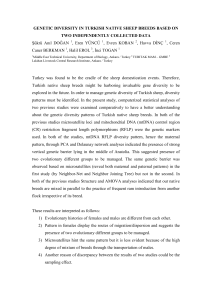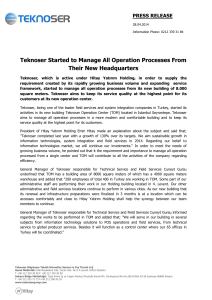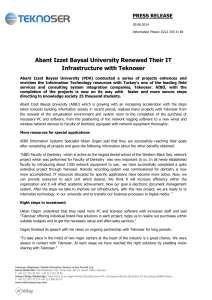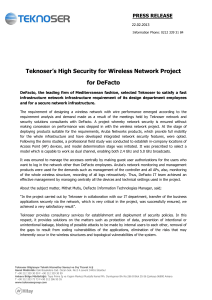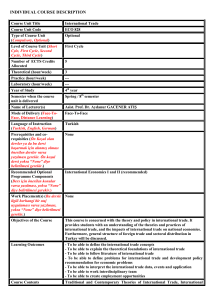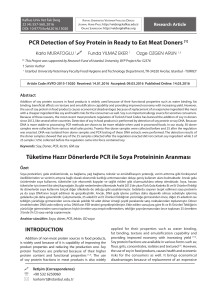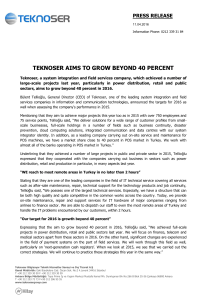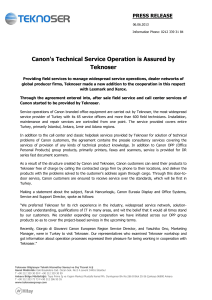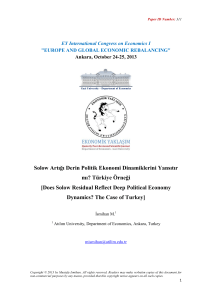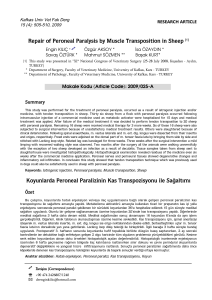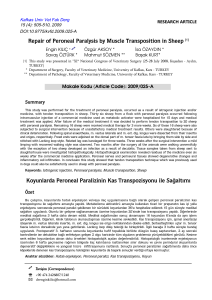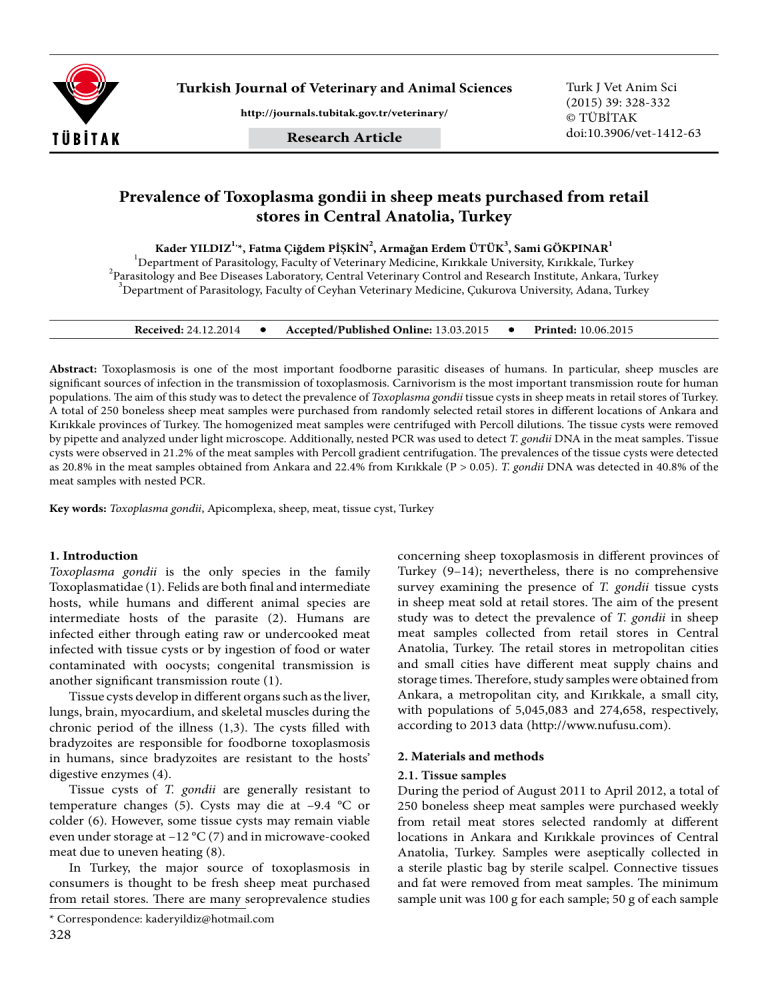
Turkish Journal of Veterinary and Animal Sciences
http://journals.tubitak.gov.tr/veterinary/
Research Article
Turk J Vet Anim Sci
(2015) 39: 328-332
© TÜBİTAK
doi:10.3906/vet-1412-63
Prevalence of Toxoplasma gondii in sheep meats purchased from retail
stores in Central Anatolia, Turkey
1,
2
3
1
Kader YILDIZ *, Fatma Çiğdem PİŞKİN , Armağan Erdem ÜTÜK , Sami GÖKPINAR
Department of Parasitology, Faculty of Veterinary Medicine, Kırıkkale University, Kırıkkale, Turkey
2
Parasitology and Bee Diseases Laboratory, Central Veterinary Control and Research Institute, Ankara, Turkey
3
Department of Parasitology, Faculty of Ceyhan Veterinary Medicine, Çukurova University, Adana, Turkey
1
Received: 24.12.2014
Accepted/Published Online: 13.03.2015
Printed: 10.06.2015
Abstract: Toxoplasmosis is one of the most important foodborne parasitic diseases of humans. In particular, sheep muscles are
significant sources of infection in the transmission of toxoplasmosis. Carnivorism is the most important transmission route for human
populations. The aim of this study was to detect the prevalence of Toxoplasma gondii tissue cysts in sheep meats in retail stores of Turkey.
A total of 250 boneless sheep meat samples were purchased from randomly selected retail stores in different locations of Ankara and
Kırıkkale provinces of Turkey. The homogenized meat samples were centrifuged with Percoll dilutions. The tissue cysts were removed
by pipette and analyzed under light microscope. Additionally, nested PCR was used to detect T. gondii DNA in the meat samples. Tissue
cysts were observed in 21.2% of the meat samples with Percoll gradient centrifugation. The prevalences of the tissue cysts were detected
as 20.8% in the meat samples obtained from Ankara and 22.4% from Kırıkkale (P > 0.05). T. gondii DNA was detected in 40.8% of the
meat samples with nested PCR.
Key words: Toxoplasma gondii, Apicomplexa, sheep, meat, tissue cyst, Turkey
1. Introduction
Toxoplasma gondii is the only species in the family
Toxoplasmatidae (1). Felids are both final and intermediate
hosts, while humans and different animal species are
intermediate hosts of the parasite (2). Humans are
infected either through eating raw or undercooked meat
infected with tissue cysts or by ingestion of food or water
contaminated with oocysts; congenital transmission is
another significant transmission route (1).
Tissue cysts develop in different organs such as the liver,
lungs, brain, myocardium, and skeletal muscles during the
chronic period of the illness (1,3). The cysts filled with
bradyzoites are responsible for foodborne toxoplasmosis
in humans, since bradyzoites are resistant to the hosts’
digestive enzymes (4).
Tissue cysts of T. gondii are generally resistant to
temperature changes (5). Cysts may die at –9.4 °C or
colder (6). However, some tissue cysts may remain viable
even under storage at –12 °C (7) and in microwave-cooked
meat due to uneven heating (8).
In Turkey, the major source of toxoplasmosis in
consumers is thought to be fresh sheep meat purchased
from retail stores. There are many seroprevalence studies
*Correspondence: [email protected]
328
concerning sheep toxoplasmosis in different provinces of
Turkey (9–14); nevertheless, there is no comprehensive
survey examining the presence of T. gondii tissue cysts
in sheep meat sold at retail stores. The aim of the present
study was to detect the prevalence of T. gondii in sheep
meat samples collected from retail stores in Central
Anatolia, Turkey. The retail stores in metropolitan cities
and small cities have different meat supply chains and
storage times. Therefore, study samples were obtained from
Ankara, a metropolitan city, and Kırıkkale, a small city,
with populations of 5,045,083 and 274,658, respectively,
according to 2013 data (http://www.nufusu.com).
2. Materials and methods
2.1. Tissue samples
During the period of August 2011 to April 2012, a total of
250 boneless sheep meat samples were purchased weekly
from retail meat stores selected randomly at different
locations in Ankara and Kırıkkale provinces of Central
Anatolia, Turkey. Samples were aseptically collected in
a sterile plastic bag by sterile scalpel. Connective tissues
and fat were removed from meat samples. The minimum
sample unit was 100 g for each sample; 50 g of each sample
YILDIZ et al. / Turk J Vet Anim Sci
was used for Percoll gradient centrifugation and the
remaining was stored at –20 °C for DNA extraction.
2.2. Percoll gradient centrifugation
Briefly, 5 g of meat sample was cut with sterile scissors
and added to 20 mL of PBS. The samples were then
homogenized using a high-speed tissue homogenizer
(OMNI Tip, USA). The homogenizer was cleaned in
boiled water before every consecutive homogenization.
The homogenates were sieved in a centrifuge tube using
separate cheesecloths. From Percoll stock solution (SigmaAldrich, USA), 90% and 30% diluted solutions in distilled
water and NaCl were prepared. Percoll dilutions and the
homogenates were centrifuged (Nuve, Turkey) at 4,000 ×
g for 20 min. Following centrifugation, the cysts found in
between the Percoll layers were removed using a Pasteur
pipette and analyzed for presence of tissue cysts by light
microscope (Olympus BX 50).
2.3. Toxoplasma gondii genomic DNA isolation
One gram of each meat sample was cut into small pieces
before being thoroughly ground into a fine powder
under liquid nitrogen. Genomic DNA was extracted by
the QIAamp DNA Mini Kit (QIAGEN, Germany) with
some modifications, and then 500 mg of the powder was
transferred to an Eppendorf tube and digested in 30 µL
of proteinase K (25 mg/mL, MBI Fermentas), 180 µL of
ATL buffer from the extraction kit, and 500 µL of DNasefree, RNase-free sterile distilled water (BioBasic, Inc.) at 56
°C overnight in a dry block (Labnet, D-1200). The DNA
extraction was then performed with 200 µL of supernatant
following centrifugation at 12,000 × g for 3 min, according
to the manufacturer.
2.4. Nested PCR amplification
Nested PCR was performed to confirm the presence of the
T. gondii B1 gene in the sheep meat homogenates. The B1
gene is a 35-fold repetitive gene and is highly conserved in
T. gondii (15). While in the first round of nested PCR, a 194bp DNA fragment of the B1 gene of T. gondii was amplified
using Toxo 1 for: 5’-GGAACTGCATCCGTTCATGAG-3’
and Toxo 2 rev: 5’-TCTTTAAAGCGTTCGTGGTC-3’
primers, in the second round, a specific 97-bp
part of the T. gondii B1 gene was amplified from
previously amplified template DNA using Toxo 3 for:
5’-TGCATAGGTTGCCAGTCACTG-3’ and Toxo 4 rev:
5’-GGCGACCAATCTGCGAATACACC-3’ primers.
PCR was carried out in a final volume of 50 µL. Master
mixes of both PCR reactions consisted of 5 µL of 10X PCR
buffer, 5 µL of 25 mM MgCl2, 4 µL of 1 mM dNTP mix,
1.5 µL of each primer (30 pmol), 0.25 µL of Taq DNA
polymerase (1.25 IU; MBI Fermentas), and 5 µL and 2 µL
of template for each round, respectively.
Amplifications were carried out in a thermal cycler
(SensoQuest, Labcycler) and the PCR conditions consisted
of an initial denaturation at 95 °C for 5 min, followed by
35 cycles of denaturation at 95 °C for 1 min, annealing at
55 °C for 1 min, and elongation at 72 °C for 1 min, with a
final elongation at 72 °C for 5 min. In every reaction, DNA
from tachyzoites of the T. gondii RH strain was included as
a positive control and ultrapure water (BioBasic, Inc.) as a
negative control.
The PCR products were separated on agarose gels
(1.5%; Sigma-Aldrich) stained with ethidium bromide
(Sigma-Aldrich) and visualized on a UV transilluminator
(UVP, M-20V).
2.5. Statistical analysis
Statistical analysis of the data was performed by using
SPSS 15.0 (SPSS Inc., Chicago, IL, USA). Chi-square test
was used to compare the data. P < 0.05 was considered
significant.
3. Results
In this study, 250 sheep meat samples from Ankara (n: 192)
and Kırıkkale (n: 58) were analyzed for T. gondii (Table).
Tissue cysts were observed in 21.2% of the meat samples
with Percoll gradient centrifugation. The prevalences of
the tissue cysts in the meat samples obtained from Ankara
and Kırıkkale were 20.8% and 22.4%, respectively (P >
0.05). The spherical tissue cysts were measured as 30–
36.5 × 25.5–32 µm in diameter (mean: 32.5 × 27.5 µm).
The wall thickness of cysts was measured as <1 µm. The
tissue cysts were confirmed as T. gondii by nested PCR.
Genomic DNA of T. gondii was detected in 40.8% of the
meat samples with nested PCR (Figure). The prevalences
Table. Distribution of T. gondii in meat samples of sheep from Ankara and Kırıkkale.
Number of
samples
T. gondii tissue
cysts positivity
(n)
(n)
%
(n)
%
Ankara
192
40
20.8
89
46.3
Kırıkkale
58
13
22.4
13
22.4
Total
250
53
21.2
102
40.8
Province
T. gondii
PCR positivity
329
YILDIZ et al. / Turk J Vet Anim Sci
Figure. T. gondii B1 gene amplification results of the tissue cyst samples selected
randomly. Lane M: marker (100 bp), N: negative control, P: positive control. Lanes 1–9:
tissue cyst samples (97-bp bands).
of T. gondii DNA in the samples were 46.3% and 22.4% in
Ankara and Kırıkkale, respectively (P < 0.001).
4. Discussion
Toxoplasma gondii causes tissue cyst formation in different
organs of intermediate hosts (3). These cysts are isolated
from the tongue, intercostal, and leg muscles in sheep
(5,16) and are important for human infections (1). Realtime PCR-positive reactions were reported in pig meat
samples (18.03%) and only one viable isolate was obtained
from PCR-positive pork meat sampled in retail stores in
China (17). The prevalence of viable T. gondii in retail
meat is very low and viable parasites were only detected
in pig meat samples in the United States (18). T. gondii
was reported in diaphragm samples of cattle at the highest
rate using real-time PCR (19). In the present study, intact
T. gondii tissue cysts were observed at 21.2% in the sheep
meat samples. Viability of these tissue cysts was unknown
since bioassay trials could not performed in this study.
Oral transmission is the major route for human
toxoplasmosis (2). Nested PCR is a useful technique for
the detection of T. gondii DNA in tissue samples (20).
However, the presence of the parasite DNA in the tissues
does not reveal the infection through carnivorism. It is well
known that PCR cannot distinguish between living and
dead organisms (1). In the present study, the molecular
prevalence in meat samples collected from Ankara was
higher when compared with Kırıkkale (46.3% vs. 22.4%).
The viability of tissue cysts in meat is affected from storage
temperature and duration in the retail stores (21). In
Turkey, metropolitan retail stores supply meat generally
from big suburban farms. After the slaughtering process,
meats are transported in bulk to metropolitan cities with
cold chain and stored in suitable refrigerators in markets.
330
However, small city markets supply limited amounts of
meat from the closest small farms and sell it in a short
time without freezing. Freezing of meat for 2 days at –12
°C is sufficient for the death of T. gondii tissue cysts (22),
even if some of them are highly resistant to temperature
changes (7). Furthermore, tissue cysts may be infectious
in meat after storage at temperatures of 1–4 °C during
3-week periods (7). T. gondii tissue cyst and parasites DNA
were detected in frozen buffalo meat samples with use of
microscopic and molecular techniques, respectively (23).
In general, raw or undercooked meat is considered
as the most important source for human foodborne
toxoplasmosis (22). This has been confirmed by
epidemiological studies based on the monitoring of
toxoplasmosis (24,25). In the present study, T. gondii
tissue cysts of sheep meat samples were observed at 20.8%
in Ankara and 22.4% in Kırıkkale. The seroprevalence
rates of human toxoplasmosis in these provinces were
reported as 28% and 22.1%, respectively (26,27). The
seropositivity rate of T. gondii in humans may be related
to traditional eating habits. In Turkey, the traditional raw
meatball called “çiğ köfte” prepared with raw sheep meat
can be an important mode of transmission. In addition
to cultural eating habits, cross-contamination of cutting
boards and knives after preparing meat in the kitchen
may be significant in the transmission of toxoplasmosis to
humans.
According to epidemiological surveys on toxoplasmosis
in Turkey, the seropositivity rates have been gradually
increasing in farm animals (9,11,13,14,28). In previous
reports, sheep toxoplasmosis was reported between
14.7% and 45.4% (9,11), whereas the seropositivity rates
have dramatically increased to 97.4%–98.92% in sheep
based on recent published reports (13,14,28). Increasing
YILDIZ et al. / Turk J Vet Anim Sci
seropositivity rates in farm animals suggest that T. gondii
may be an important health problem for humans in the
future. Although T. gondii is one of the most studied
parasites, there are still many questions that have to be
addressed. Today, in respect to public health, one of
the most important issues is to prevent transmission of
toxoplasmosis among hosts including humans. In addition
to the basic control measurements, public awareness is
necessary to prevent the transmission of toxoplasmosis.
Acknowledgments
This work was supported by a grant from the Kırıkkale
University Scientific Research Unit (Project number: 2011–
32). This research was presented at the 12th International
Symposium Prospects for the 3rd Millennium Agriculture
University of Agricultural Sciences and Veterinary
Medicine, Cluj-Napoca, Romania, 26–28 September 2013.
The authors would like to thank Dr Cahit Babür of the
Public Health Institution of Turkey.
References
1. Dubey JP. Toxoplasmosis of Animals and Humans. 2nd ed.
Boca Raton, FL, USA: CRC Press; 2010.
2. 3. Eckert J, Friedhoff KT, Zahner H, Deplazes P. Lehrbuch der
Parasitologie für die Tiermedizin. Stuttgart, Germany: Enke
Verlag; 2005 (in German).
Hill DE, Chirukandoth S, Dubey JP. Biology and epidemiology
of Toxoplasma gondii in man and animals. Anim Health Res
Rev 2005; 6: 41–61.
4. Weiss LM, Kim K. Toxoplasma gondii, The Model
Apicomplexan: Perspectives and Methods. Amsterdam, the
Netherlands: Academic Press; 2007.
5. Dubey JP, Kirkbridge CA. Enzootic toxoplasmosis in sheep in
North-Central United States. J Parasitol 1989; 75: 673–676.
6. Kotula AW, Dubey JP, Sharar AK, Andrews CD, Shen SK,
Lindsay DS. Effect of freezing on infectivity of Toxoplasma
gondii tissue cysts in pork. J Food Prot 1991; 54: 687–690.
7. Tenter AM. Toxoplasma gondii in animals used for human
consumption. Mems Inst Oswaldo Cruz 2009; 104: 364–369.
8. Lunden A, Uggla A. Infectivity of Toxoplasma gondii in mutton
following curing, smoking, freezing or microwave cooking. Int
J Food Microbiol 1992; 15: 357–363.
9. Zeybek H, Yaralı C, Nishikawa H, Nishikawa F, Dündar
B. Ankara yöresi koyunlarında Toxoplasma gondii’nin
prevalansının saptanması. Etlik Vet Mikrobiyol Derg 1995; 8:
80–86 (in Turkish).
10. Yıldız K, Babür C, Kılıç S, Aydenizöz M, Dalkılıç İ. Investigation
of anti-Toxoplasma antibodies in slaughtered sheep and cattle
as well as in workers in the abattoir of Kırıkkale. Türkiye
Parazitol Derg 2000; 24: 180–185 (in Turkish with abstract in
English).
11. Babür C, Esen B, Bıyıkoğlu G. Seroprevalence of Toxoplasmosis
gondii in sheep in Yozgat, Turkey. Turk J Vet Anim Sci 2001; 25:
283–285 (in Turkish with abstract in English).
12. Acici M, Babur C, Kilic S, Hokelek M, Kurt M. Prevalence
of antibodies to Toxoplasma gondii infection in humans and
domestic animals in Samsun province, Turkey. Trop Anim
Health Prod 2008, 40: 311–315.
13. Mor N, Arslan MO. Seroprevalence of Toxoplasma gondii in
sheep in Kars Province. Kafkas Univ Vet Fak Derg 2007; 13:
165–170.
14. Leblebicier A, Yıldız K. Seroprevalence of Toxoplasma gondii in
sheep in Silopi district by using indirect fluorescent antibody
test (IFAT). Türkiye Parazitol Derg 2014; 38: 1–4 (in Turkish
with abstract in English).
15. Burg JL, Grover CM, Pouletty P, Boothroyd JC. Direct and
sensitive detection of a pathogenic protozoan, Toxoplasma
gondii, by polymerase chain reaction. J Clin Microbiol 1989;
27: 1787–1792.
16. Yıldız K, Kul O, Gökpınar S, Atmaca HT, Gençay YE,
Gazyağcı AN, Babür C, Gürcan İS. The relationship between
seropositivity and tissue cysts in sheep naturally infected with
Toxoplasma gondii. Turk J Vet Anim Sci 2014; 38: 169–175.
17. Wang H, Wang T, Luo Q, Huo X, Wang L, Liu T, Xu X, Wang
Y, Lu F, Lun Z et al. Prevalence and genotypes of Toxoplasma
gondii in pork from retail meat stores in Eastern China. Int J
Food Microbiol 2012; 157: 393–397.
18. Dubey JP, Hill DE, Jones JL, Hightower AW, Kirkland E,
Roberts JM, Marcet PL, Lehmann T, Vianna MCB, Miska K
et al. Prevalence of viable Toxoplasma gondii in beef, chicken,
and pork from retail meat stores in the United States: risk
assessment to consumers. Int J Parasitol 2005; 91: 1082–1093.
19. Berger-Schoch AE, Herrmann DC, Schares G, Müller N,
Bernet D, Gottstein B, Frey CF. Prevalence and genotypes of
Toxoplasma gondii in feline faeces (oocysts) and meat from
sheep, cattle and pigs in Switzerland. Vet Parasitol 2011; 177:
290–297.
20. Ortega-Mora LM, Gottstein B, Conraths FJ, Buxton D.
Protozoal Abortion in Farm Ruminants: Guidelines for
Diagnosis and Control. Wallingford, UK: CAB International;
2007.
21. Hill DE, Benedetto SM, Coss C, McCrary JL, Fournet VM,
Dubey JP. Effects of time and temperature on the viability of
Toxoplasma gondii tissue cysts in enhanced pork loin. J Food
Prot 2006; 69: 1961–1965.
22. Kijlstra A, Jongert E. Toxoplasma-safe meat: close to reality?
Trends Parasitol 2008; 25: 18–22.
23. Gencay YE, Yildiz K, Gokpinar S, Leblebicier A. A potential
infection source for humans: frozen buffalo meat can harbour
tissue cysts of Toxoplasma gondii. Food Control 2013; 30: 86–
89.
331
YILDIZ et al. / Turk J Vet Anim Sci
24. Cook AJ, Gilbert RE, Buffolano W. Sources of toxoplasma
infection in pregnant women: European multicentre casecontrol study. European Research Network on Congenital
Toxoplasmosis. BMJ 2000; 321: 142–147.
25. Boyer KM, Holfels E, Roizen N, Swisher C, Mack D,
Remington J, Withers S, Meier P, McLeod R; Toxoplasmosis
Study Group. Risk factors for Toxoplasma gondii infection in
mothers of infants with congenital toxoplasmosis: implications
for prenatal management and screening. Am J Obstet Gynecol,
2005; 192: 564–571.
26. Apan TZ. Kırıkkale Universitesi Tıp Fakültesi Polikliniklerine
başvuran kadın hastalarda TORCH etkenlerinin ELISA ile
retrospektif olarak değerlendirilmesi. Kırıkkale Univ Tıp Fak
Derg 2001; 3: 7–11 (in Turkish).
332
27. Mumcuoğlu İ, Toyran A, Çetin F, Coşkun FA, Baran I, Aksu
N, Aksoy A. Evaluation of the toxoplasmosis seroprevalence
in pregnant women and creating a diagnostic algorithm.
Mikrobiyol Bul 2014; 48: 283–291 (in Turkish with abstract in
English).
28. Çiçek H, Babür C, Eser M. Seroprevalence of Toxoplasma
gondii in Pırlak sheep in the Afyonkarahisar Province of
Turkey. Türkiye Parazitol Derg 2011; 35: 137–139 (in Turkish
with abstract in English).

